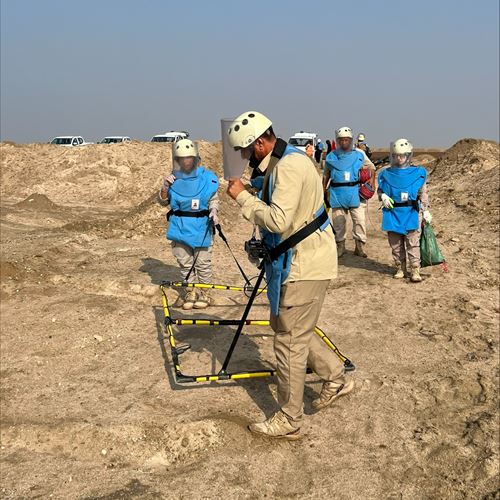Helping to clear the way for Iraq's journey to recovery
On Mine Action Day 2024, we delve into Iraq’s journey towards recovery and highlight the crucial role that organisations like DRC play in supporting the country road to eradicating some of the most indiscriminate weapons of war.

Iraq stands as a poignant reminder of the enduring legacy of conflict. Transitioning from a humanitarian to a development context, Iraq continues to grapple with the aftermath of decades of war, with communities facing ongoing risks from landmines, cluster munitions and unexploded remnants of war.
The 1980–1988 Iran-Iraq War, the 1991 Gulf War, and the 2003 invasion, left vast expanses of Iraqi territory contaminated by landmines and unexploded remnants of war, predominantly along the eastern border with Iran and southwestern border with Saudi Arabia.
Remains of cluster munitions – airborne weapons that disperse several to many hundreds of explosive submunitions, or "bomblets," over a wide areai - also plague large areas of Iraq, predominantly in central and southern regions.
The widespread use of improvised devices by ISIS during its occupation of certain areas further compounds the issue.
Iraq has made promising global commitments as one of the few Middle Easter countries signatory to both the Mine Ban Treaty and the Convention on Cluster Munitions, yet the contamination of the country surpasses its capacity for timely clearance, with the country failing to meet its clearance deadline outline in Article 4 of the Convention on Cluster Munitions, which was set for 1 November 2023. Iraq was granted a five-year extension with a revised deadline set for 1 November 2028.
To meet this deadline, Iraq and its local and international partners will need to scale up their response to mine clearance. DRC remains steadfast in its commitment to assist Iraq in its ongoing endeavour.
DRC has been working in Basra, a region once famed for its cultivation of palm trees, since 2003. Nestled in the south of the country, Basra has been blessed and cursed by its location between Kuwait and Iran.
Both the Iran-Iraq War and the Gulf war saw periods of intense fighting in Basra, causing the region to be the most contaminated in Iraq.
In Basra last year, DRC cleared 2,731,389 square meters of battlefield areas, conducted quality assurance checks on an additional 652,645 square meters of land, and provided explosive ordnance risk education outreach to 11,466 individuals regarding the hazards posed by unexploded remnants of war.
Battle Area Clearance also plays a vital role in restoring safety and stability. DRC conducts systematic clearance operations to remove explosive remnants of war from areas that saw conflict, ensuring that communities can safely move across or reclaim lands without fear.
DRC also carries out quality assurance checks to ensure that areas of land already cleared adhere to the standards outlined in the International Mine Action Standards (IMAS).
These clearance and checks ensure communities can finally move on from the devastation of war. DRC recently cleared a contaminated neighbourhood, Alhuta, in Basra located near to the Shat Alarab river. This allowed residents to finally move home and begin growing crops once more, without fear.
Raaid, a resident of the area reflected on DRC’s impact: “This land has been contaminated for a long time. All the houses and farms were affected, causing numerous accidents and casualties. Some people lost their lives, and a woman from our neighbours lost her legs. Due to the contamination, we left the land and relocated to another area.
We contacted DRC, and they cleared all the land of explosive ordnance. After the clearance, we safely returned to our land. Since our return, we have been using the land and have planted palm trees.”
Clearance of contaminated land has become more critical than ever, as internally displaced persons displaced due to conflict living in informal sites in Federal Iraq and IDP camps in Kurdistan Region look to return home, areas which remain largely contaminated.
Iraqi’s are facing another threat which is causing more and more people to be displaced – namely climate change. It is estimated that already 130,000 people have been displaced due to climate change. It is also estimated that 40% of arable land in southern parts of the country, including Basra, will be lost due to desertification, further increasing populations forced to move from their land.
With this, it is critical that land is safely cleared for people to travel across and settle on as they search for new homes.
As we commemorate Mine Action Day, DRC remains steadfast in our dedication to protecting vulnerable populations and fostering resilience in conflict-affected areas.